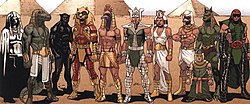Publication history
Characters based on ancient Egyptian deities were first mentioned in Captain America Comics #20 (November 1942), published by Marvel Comics' predecessor Timely Comics, in which Captain America and Bucky investigate the murder of Colonel Fitzpatrick, who was studying the Book of Thoth while stationed in Egypt. [1] The Heliopolitans' first full Golden Age appearance was in the story "The Terror That Creeps" by Stan Lee and Werner Roth, published in Marvel Tales #96 (June 1950), and involves a man that fails to convince the public that the Great Sphinx of Giza is slowly moving to the edge of the desert, where it will be empowered by Set and destroy mankind. [2] The goddess Bast would later make her first appearance (as a totem) with the Black Panther in Fantastic Four #52 (July 1966), being called only Panther God, in Black Panther vol. 3 # 21 by Christopher Priest and Sal Velutto, it was revealed that the Panther God is Bast. [3] [4] [5] Many of the other deities, including Horus, Isis and Osiris, were introduced in Thor #239 (September 1975). [6] Khonshu, who became associated with Moon Knight, first appeared in Moon Knight #1 (November 1980). [7] Joseph Muszynski argued in his book Everything I Needed to Know About Life I Learned from Marvel Comics that the introduction of Egyptian deities "excited our tendency to enjoy variety" as the pantheon contained multiple gods and personalities as opposed to the Judeo-Christian religions. [8] Ed Strauss contended that Marvel was able to dive into ancient Egyptian religion because it "had long been retired into the realm of mythology" unlike Christianity. [9]
Fictional history
The Heliopolitans were worshipped as deities by the inhabitants of the Nile River Valley from as early as 10,000 BC. According to Heliopolitan legend, the first of these were Gaea (as Neith), the Demiurge (as Nun), and Set (as Apep/Apophis). Neith and Nun sired Atum, the first of the Ogdoad — the old gods. As Neith went about creating mortal life, Set desired to destroy her creations. In turn, Neith called Atum for protection. Atum and Set fought for eons until Atum transformed into the Demogorge and drove Set off. After Set's defeat, Atum begot the Ennead — the new gods, took the name Ra and settled in the sun. [4]
The Ennead resided in the ancient city of Heliopolis until their king Osiris placed mortal pharaohs in charge so that the gods could become less involved with human affairs and relocated themselves to the extradimensional realm of Celestial Heliopolis, known to the ancient Egyptians as "Aaru." [4] A few, including Bast, Sobek, Sekhmet, Thoth, and Ptah choose to remain on Earth, integrating themselves into The Orisha, the pantheon of Wakanda. [10] [11] Bast would eventually become the patron deity of Wakanda, while Sobek and Sekhmet became patrons of lesser influential Wakandan cults. [4] Eons ago during the First Blasphemy, Khonshu tries to avenge a prisoner that was killed by Varnae only for Bast to tell Khonshu to stay his hand. Varnae who stole Vibranium from the Fires of Ptah and planned to ascend to godhood. This attracted the attention of Khonshu who met with Bast, Eshu, Gherke, and Ptah during Ra's slumber. He wants the gods in the surrounding realms to be made aware before he retaliates. He gets their support alongside the support of Kokou the Ever-Burning. In the distant past, Bast and Gherke lead the Enneads and the Orishas against Varnae's forces. Kokou confronts Varnae in his temple. The prisoners are evacuated as Bast instructs the black panthers to take the prisoners west and wait for the news of victory. [12]
In Celestial Heliopolis, Seth murdered his brother Osiris in an attempted coup but Osiris' wife Isis, and his sons Horus and Anubis combined their powers to resurrect Osiris. Osiris then dispatched Horus to exact revenge on Seth in a battle that lasted for several hundred years, ending when Seth gained the upper hand and sealed the gods in a pyramid. [4] The trapped gods remained in the pyramid for several millennia until they managed to reach out to the Asgardian god Odin. With help from Odin's son, Thor, they defeated Seth, severing his left hand as they battled, and freed the Heliopolitans. [13] The Heliopolitans had captured a large creature called the Devourer, who later escaped and fought Thor and the Thing. [14]
Osiris later empowered Thor to revive Asgardians who were harmed by the Destroyer. [15]
The gods of Heliopolis, powerless and calling themselves "Lost Ones", joined Thor and Earth Force in fighting Seth and his forces again, and ultimately regained their powers after the apparent death of Seth. [16]
The series Moon Knight: City of the Dead reveals that Heliopolitan Taweret assists in the judgement of souls in Duat. Additionally, Anubis becomes the benefactor of the Cult of the Jackal and resurrects deceased Moon Knight enemies Black Spectre, Chainsaw, Master Sniper, Midnight, Plasma, and Taurus, who form the Legion of the Unliving alongside Jackal Knight. [17]
This page is based on this
Wikipedia article Text is available under the
CC BY-SA 4.0 license; additional terms may apply.
Images, videos and audio are available under their respective licenses.
